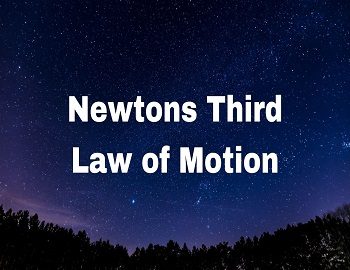Newtons Third Law of Motion:
According to Newton’s Third Law of Motion, if a body exerts a force on some other body, then the second body exerts a force of the same magnitude but in opposite direction on the first body. Newtons Third Law of Motion may be stated as follows-
To every action, there is an equal and opposite reaction.
For the illustration of Newton’s Third Law of Motion, consider the following examples-
- A ball thrown against a hard surface (action) rebounds with equal and opposite force (reaction).
- A bullet fired from the gun (action) pushes the gun backward (reaction).
- While walking on the ground, we exert a force over it by our foot (action), and our body is pushed forward by the ground (reaction).
- When an athlete takes a jump, he presses the ground backward (action) and the ground throws him forward (reaction).
- Due to the escaping gases from its rear end (action), the rocket moves upwards (reaction).
Law of Conservation of Momentum:
Let us discuss the change in momentum when two bodies moving in the same direction collide.
Consider two bodies A of mass m1 and B of mass m2 moving in the same direction with velocities μ1 and μ2 respectively. Let these bodies collide for a short time t and acquire the velocities ν1 and ν2 after the collision. Let the force experienced by A be FA and by B be FB during the time of the collision. Then-
According to Newton’s second law of motion,
FA = Force on body A = m1 (ν1 – μ1) / t
FB = Force on body B = m2 (ν2 – μ2) / t
According to Newton’s third law of motion, the force FA should be equal and opposite to the force FB.
Therefore, FA = – FB
or m1 (ν1 – μ1) / t = -m2 (ν2 – μ2) / t
or m1 (ν1 – μ1) = -m2 (ν2 – μ2)
or m1ν1 + m2ν2 = m1μ1 + m2μ2
Thus, the total momentum before the collision (m1μ1 + m2μ2) is equal to the total momentum after the collision. This shows that there is no change in the momentum of the system due to the action and reaction of the bodies A and B forming the system. This may be generalized by saying that the total momentum of the system is conserved when no external force acts on the system. This is called the law of conservation of momentum.
- Asexual Reproduction- Types, Characteristics, And Significance
- Vegetative Propagation: Natural & Artificial Methods
- Parthenogenesis: Types And Significance
- Pollination: Types and Its Importance
- Chlorophyta- Green Algae
- Rhodophyta- Red Algae
- Bryophytes- Characteristics And Economic Importance
- Essential and Non-essential Parts of the Flowers
- Cell Structure and Function– NIOS









Comments (No)